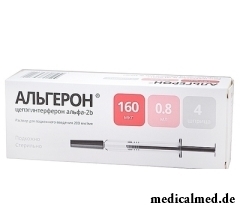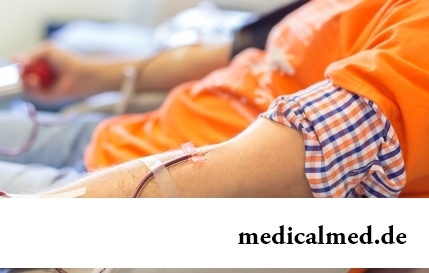





Algeron
Application instruction:
 Algeron – the drug with the immunostimulating, antiviral action applied at treatment of primary chronic active hepatitis C.
Algeron – the drug with the immunostimulating, antiviral action applied at treatment of primary chronic active hepatitis C.
Form of release and structure
Algeron release in the form of solution for hypodermic introduction: transparent, from light yellow color to colourless (in sterile ternary syringes from neutral colourless glass on 0,4, 0,5, 0,6, 0,8 or 1 ml, on 1 syringe in blister strip packagings from a polymeric film, on 1 or 4 packagings in a cardboard pack; in colourless glass bottles on 1 ml, on 1 or 4 bottles in blister strip packagings, on 1 packaging in a cardboard pack).
Structure of 1 ml of solution:
- Active ingredient: цепэгинтерферон alpha 2b – 0,2 mg;
- Additional components: a dihydrate of an edetat of dinatrium – 0,056 mg, polysorbate of 80 - 0,05 mg, sodium acetate trihydrate – 2,617 mg, sodium chloride – 8 mg, glacial acetic acid – to pH 5,0, water for injections – to 1 ml.
Indications to use
Algeron appoint the adult in combination with ribaviriny for treatment of primary chronic active hepatitis C from positive HCV RNA in cases of lack of signs of a decompensation of a disease of a liver.
Contraindications
Absolute:
- The cirrhosis proceeding with a liver failure at HIV coinfection / chronic hepatitis C (at the Chayld-Pyyu index> 6);
- Dekompensirovanny cirrhosis (on a scale of Chayld-Pyyu the class B and C or bleeding from varicose expanded veins);
- Autoimmune hepatitis or other autoimmune diseases in the anamnesis;
- Functional disturbances of a thyroid gland which it is medicamentous do not manage to be supported at the normal level;
- Functional disturbances of the central nervous system and/or epilepsy;
- Serious mental diseases, in particular, suicide attempts or thoughts, depressions (including in the anamnesis);
- Malignant new growths;
- Performing treatment at men whose partners are pregnant;
- Serious illnesses of cardiovascular system, including the uncontrollable and unstable forms existing at least for half a year preceding therapy;
- Serious illnesses of kidneys (including a renal failure, need of carrying out a hemodialysis, clearance of creatinine <50 ml/min.);
- The expressed oppression of a marrowy hemopoiesis (thrombocytes <25×109/л, neutrophils <0,5×109/л, hemoglobin <85 g/l);
- Rare hereditary diseases, such as lactose intolerance, glyukozo-galaktozny malabsorption or deficit of lactase;
- Hemoglobinopathies (for example, sickemia, thalassemia);
- Age up to 18 years;
- Pregnancy and period of a lactation;
- Hypersensitivity to drug components, and also to a ribavirin.
Relative (Algeron appoint with care in the presence of the following diseases / states):
- Diabetes mellitus in the presence of a tendency to development of a ketoatsidotichesky coma;
- Serious illnesses of lungs (for example, chronic obstructive diseases of lungs);
- Thrombocytes <90×109/л, neutrophils <1,5×109/л, hemoglobin <100 g/l;
- HIV coinfection / chronic hepatitis C with number of CD4+ of lymphocytes is less than 200 cells / мкл or less than 100 cells / мкл at the HIV RNA level more than 5000 copies/ml;
- The disturbance blood connected with coagulant system (for example, at the postponed embolism of a pulmonary artery, thrombophlebitis);
- The combined use with miyelotoksichny medicines.
Route of administration and dosage
Algeron enter subcutaneously, into the area of a hip or a front abdominal wall. Intravenously it is impossible to administer the drug. Places for an injection are recommended to be alternated.
Has to appoint drug and to control its further use the doctor with experience of therapy of patients with hepatitis C.
The recommended mode of dosing of Algeron (0,0015 mg/kg once a week) in combination with ribaviriny (the minimum volume of the syringe/weight / a one-time dose/volume of solution):
The syringe on 0,4 ml:
- 40 kg: 0,06 mg / 0,3 ml;
- 41-46 kg: 0,07 mg / 0,35 ml;
- 47-53 kg: 0,08 mg / 0,4 ml.
The syringe on 0,5 ml:
- 54-60 kg: 0,09 mg / 0,45 ml;
- 61-66 kg: 0,1 mg / 0,5 ml.
The syringe on 0,6 ml:
- 67-73 kg: 0,11 mg / 0,55 ml;
- 74-80 kg: 0,12 mg / 0,6 ml.
The syringe on 0,8 ml:
- 81-86 kg: 0,13 mg / 0,65 ml;
- 87-93 kg: 0,14 mg / 0,7 ml;
- 94-100 kg: 0,15 mg / 0,75 ml;
- 101-106 kg: 0,16 mg / 0,8 ml.
The syringe on 1 ml:
- 107-113 kg: 0,17 mg / 0,85 ml;
- 114-120 kg: 0,18 mg / 0,9 ml;
- 121-126 kg: 0,19 mg / 0,95 ml;
- 127-133 kg: 0,2 mg / 1 ml.
Each bottle / syringe with solution is intended only for single use. To mix the solution which is contained in the bottle/syringe or it is not necessary to enter it in parallel with other medicines.
Administration of solution in painful points, areas with small knots and consolidations or the reddened, decoloured sites of skin is not recommended.
It is impossible to apply a double dose of Algeron.
Without consultation with the doctor it is not necessary to cancel therapy.
Ribavirin accept inside, along with meal, daily. The daily dose is defined by body weight (a single dose morning/evening):
- To 65 kg: 400 mg / 400 mg;
- 65-85 kg: 400 mg / 600 mg;
- 86-105 kg: 600 mg / 600 mg;
- From 105 kg: 600 mg / 800 mg.
Duration of a therapeutic course is defined by a virus genotype:
- HCV 1 genotype: the early virologic answer (disappearance by 12th week of treatment of HCV RNA or decrease in virus load of 2 log10 (by 100 times) and more) can predict achievement of the steady answer. In this case it is recommended to continue treatment within 9 months (the general duration of a course – 48 weeks). If the early virologic answer is absent, achievement of remission is improbable;
- Genotype of HCV 2 and 3: at the early virologic answer by 12th week of therapy it is recommended to be seen off for 12 more weeks (the general duration of a course – 24 weeks). More long treatment has no advantages;
- HCV 4 genotype: patients with a genotype 4, in general, will respond to treatment difficult. As a rule, adhere to the same tactics of treatment, as at a genotype 1.
In cases of development of the undesirable phenomena or deviations of laboratory indicators of moderate severity it is necessary to lower Algeron's doses or a ribavirin or to suspend therapy. The question of increase in a dose, up to initial, can be considered after normalization of a state or laboratory indicators.
Correction of the mode of dosing is required at development of hematologic disturbances.
About 600 mg at decrease in hemoglobin to level less than 100 g/l are recommended to lower a daily dose of a ribavirin. At decrease in this indicator less than 85 g/l Algeron and рибавирин cancel. Extra care is demanded by patients with diseases of cardiovascular system.
At increase in concentration of free bilirubin up to 85,5 µmol/l about 600 mg are recommended to lower a daily dose of a ribavirin.
Algeron and рибавирин cancel at the progressing increase in activity of alaninaminotranspherase or aspartate aminotransferase more than twice from a reference value or it is more, than by 10 times from the upper bound of norm.
In cases of developing of a moderately severe depression Algeron's dose is reduced. Therapy is cancelled at development of a heavy depression, and also emergence of suicide thoughts.
At a slight renal failure (clearance of creatinine> of 50 ml/min.) when carrying out a combination therapy concerning development of anemia it is necessary to be careful.
Side effects
Side effects when performing the combined therapy of 0,0015 mg/kg a week of Algeron with ribaviriny in most cases had the easy or moderately expressed character and the terminations of treatment did not demand.
Possible side reactions (it is very frequent (≥1/10), it is frequent (≥1/100; <1/10), infrequently (≥1/1000; <1/100), it is rare (≥1/10 000; <1/1000), it is very rare (<1/10 000)):
- Alimentary system: very often – diarrhea, nausea; often – heartburn, a loss of appetite, dryness in a mouth, an abdominal pain;
- Central and peripheral nervous system: very often – a headache, a depression, irritability, emotional lability; often – dizziness;
- Cardiovascular system: often – arterial hypotension, tachycardia;
- Lymphatic and hemopoietic system: very often – a leukopenia, anemia, a neutropenia, thrombocytopenia. Most often reduction of hematologic indicators is noted in the first month of therapy, after dose adjustment within 1-2 months they improve;
- Respiratory system: very often – dry cough;
- Skeletal and muscular system: very often – muscular and joint pains;
- Mucous membranes: often – stomatitis, conjunctivitis, an ulitis, a blepharitis;
- Skin and hypodermic fatty tissue: very often – a skin itch, a peeling and a xeroderma, rash; often – an alopecia;
- Laboratory indicators: very often – a gipertriglitseridemiya, a hypoglycemia; often – changes of levels of hormones of a thyroid gland (increase in concentration of TTG), a hyperglycemia;
- Reactions in an injection site: very often – an inflammation in an injection site; often – infiltrate, pain, an itch in an injection site;
- General symptoms: very often – fever, an adynamy, a grippopodobny syndrome, increased fatigue, reduction of weight.
At Algeron's use in a dose of 0,002 mg/kg a week in addition to the disturbances described above the following side effects were also recorded: pains in heart, a menorrhagia, disturbances in injection sites in the form of cyanosis, dot hemorrhage, a furuncle.
The disturbances observed at a combination therapy of similar drugs of peginterferon an alpha - 2b with ribaviriny:
- Alimentary system: very often – nausea, an abdominal pain, diarrhea, appetite reduction; often – an unstable chair, dyspepsia, locks, vomiting, dryness in a mouth, abdominal distention, a stomacace, bleeding of gums, stomatitis, a glossitis; seldom – pancreatitis; very seldom – ulcer and ischemic colitis; with an unspecified frequency – disturbances of teeth and a periodontium;
- Central and peripheral nervous system: very often – sleeplessness, a depression, a headache, dizziness, irritability, disturbance of concentration of attention, feeling of alarm; often – a hypesthesia, disturbance of flavoring feelings, paresthesia, an ataxy, emotional lability, confusion of consciousness, decrease a libido, a tremor, an agressive behavior, drowsiness, a hyperesthesia, excitability, apathy, a syncope; seldom – suicide attempts and thoughts, psychosis (including hallucinations, the agressive behavior sometimes directed on people around), peripheral neuropathy, convulsive attacks; very seldom – cerebrovascular ischemia, a hematencephalon, polyneuropathy, encephalopathy; with an unspecified frequency – paralysis of a facial nerve, neuropathy (including mononeuropathy);
- Respiratory system: very often – cough, short wind, pharyngitis; often – a rhinorrhea, rhinitis, bronchitis, sinusitis, respiratory disturbances, a nose congestion, unproductive cough; very seldom – a pneumonitis, pulmonary infiltrates, an intersticial pneumonitis;
- Skeletal and muscular system: very often – musculoskeletal and joint pains; often – arthritis;
- Lymphatic and hemopoietic system: very often – anemia, a neutropenia; often – thrombocytopenia, a neutropenia, a lymphadenopathy; very seldom – a pancytopenia, aplastic anemia, a trombotichesky and idiopathic Werlhof's disease;
- Cardiovascular system: often – tachycardia, heartbeat, arterial hypertensia / hypotension, inflows; seldom – a cardiomyopathy, arrhythmia;
- Endocrine system: often – a hyperthyroidism, a hypothyroidism;
- Hypodermic fatty tissue and skin: very often – an alopecia, a xeroderma, an itch, rash; often – eczema, psoriasis, deterioration in a course of already existing psoriasis, reactions of a photosensitization, erythematic and makulopapulezny rash, dermatitis, the increased perspiration, an acne, disturbances of skin, nails and structure of hair, a furunculosis, a hematoma; seldom – a miositis, рабдомиолиз; very seldom – a toxic epidermal necrolysis, Stephen-Johnson's syndrome, a multiformny exudative erythema;
- Gepatobiliarny system: often – jaundice, a hepatomegalia;
- Immune system: very seldom – a sarcoidosis (development or an aggravation); with an unspecified frequency – a syndrome of Fogta-Koyanagi-Harady, a vasculitis, a system lupus erythematosus, a pseudorheumatism (development or an aggravation), reactions of acute hypersensitivity, including a small tortoiseshell, a bronchospasm, a Quincke's disease, an anaphylaxis;
- Urinary system and kidneys: often – the speeded-up urination, a polyuria; seldom – a renal failure, an impaired renal function; very seldom – a nephrotic syndrome;
- Reproductive system: often – a hypermenorrhea, an amenorrhea, a dysmenorrhea, dysfunction of ovaries, mammary gland pain, disturbances of a vagina (at women); prostatitis, impotence, disturbances of sexual function (at men);
- Acoustic organs: often – a sonitus, a loss/hearing disorder, average otitis;
- Organs of sight: often – conjunctivitis, eye pain, sight misting, defeat of the lacrimal gland; seldom – a retinopathy, an eye retinal apoplexy, obstruction of veins or arteries of a retina, focal changes of a retina, an optic neuritis, restriction of fields of vision or decrease in visual acuity, a papilledema;
- Laboratory indicators: often – a hyperbilirubinemia, increase in activity of alaninaminotranspherase, a hyperuricemia, changes of levels of hormones of a thyroid gland (hyper - and a hypothyroidism), hyper - and a hypoglycemia, a hypocalcemia; very seldom – a hyper lactacidemia, a gipertriglitseridemiya, a lactacidemia;
- CD4 + lymphocytes: often – reversible decrease in absolute quantity of CD4+ of lymphocytes without change of their percentage. These changes have completely reversible character; the negative impact on the level of virus loading of HIV at patients with HIV coinfection / chronic hepatitis C in time and after the end of therapy was not noted;
- Reactions in an injection site: very often – an inflammation and pain in an injection site;
- General disturbances: very often – a grippopodobny syndrome, fever, an adynamy, increased fatigue, a fever, weight reduction; often – an indisposition, pains in right hypochondrium and a thorax, thirst;
- Others: often – fungal/viral infections.
Special instructions
The profile of safety of Algeron (monotherapy or in combination with ribaviriny) for patients is younger than 18 years, and also patients after transplantation of a liver or other bodies is not studied.
Algeron's appointment to patients with heavy mental disturbances (including the patients having instructions on such disturbances in the anamnesis) is possible only after carrying out careful individual inspection and the corresponding treatment of a mental disorder.
With a depression in the anamnesis it is necessary to watch a condition of patients regarding emergence of symptoms of a depression during therapy and for half a year after its termination. At increase or preservation of symptoms, in particular a depression, an agressive behavior or suicide intentions, it is necessary to cancel Algeron and to provide timely survey by the psychiatrist.
At heart troubles before the beginning and during treatment carrying out an ECG is recommended. The anemia caused by reception of a ribavirin can aggravate the course of cardiovascular diseases. At an aggravation of symptoms therapy is cancelled.
In case of a bronchospasm, a small tortoiseshell, anaphylactic reactions, a Quincke's disease it is necessary to cancel immediately Algeron and to immediately appoint the corresponding treatment. At passing rash cancellation of therapy is not required.
At reduced function of kidneys, and also patients aged from 50 years at Algeron's use with ribaviriny need to trace carefully a state concerning possible development of anemia.
Prior to therapy carrying out a research of function of kidneys is recommended to all patients. Less than 50 ml/min. do not appoint a combination therapy at clearance of creatinine.
In case of development of a liver failure treatment is cancelled.
Also during therapy it is necessary to consider development of the following disturbances / states:
- Fever: at persistent fever it is necessary to exclude existence of other reasons;
- Hydration: it is recommended to provide adequate hydration (to avoid development of the arterial hypotension connected with reduction of volume of liquid in an organism);
- Pulmonary diseases: at development of respiratory symptoms, including cough, fever and asthma, it is necessary to carry out a thorax X-ray analysis;
- Autoimmune disorders: in some cases there can be autoantibodies (in most cases with predisposition to development of autoimmune disorders). At psoriasis and a sarcoidosis Algeron appoint with care, at an aggravation therapy cancellation is possible;
- Infections (virus/bacterial/fungal): in cases of development of heavy complications Algeron cancel;
- Changes from an organ of sight: in cases of emergence of complaints it is necessary to conduct ophthalmologic examination;
- Changes from a periodontium and teeth: carrying out regular surveys at the stomatologist (because of high probability of development of pathological changes is recommended from peridental fabrics and teeth);
- Condition of a thyroid gland: development of a hypothyroidism or hyperthyroidism is possible. In cases if activity of thyritropic hormone does not manage to be maintained at the normal level, Algeron cancel;
- Pancreatitis: at emergence of symptoms of pancreatitis therapy is cancelled;
- Laboratory researches: standard clinical and biochemical analyses of blood need to be carried out before purpose of a course, and also during therapy.
Algeron's use can be followed by development of ulcer and hemorrhagic and/or ischemic colitis within 12 weeks from the moment of an initiation of treatment. Typical signs of manifestation of colitis: availability of blood in Calais, abdominal pains, fever. At emergence of similar complaints Algeron cancel at once.
If during performing therapy development of dizziness, weakness, confusion of consciousness, drowsiness is observed, control of motor transport and works with mechanisms and cars it is necessary to refuse.
Medicinal interaction
At the combined use of Algeron with some substances / medicines development of the following effects is possible:
- Medicines in which metabolism isoenzymes of CYP2D6 or CYP2C8/C9 participate: increase in activity of these isoenzymes is noted (the combination demands care);
- Theophylline: inhibition of activity of an isoenzyme 1A2 of P450 cytochrome and increase in the area under a curve "concentration time" (AUC) of theophylline (it is necessary to carry out control of its concentration and to adjust a dose);
- Methadone: increase in the average levels of its metabolites (control of symptoms of intoxication is required);
- Highly active anti-retrovirus therapy (VAART) at sick HIV: increase in risk of development of lactic acidosis (the combination demands care).
The combination of a ribavirin with didanoziny is not recommended (possibly development of peripheral neuropathy, fatal liver failure, a symptomatic lactacidemia and pancreatitis).
Terms and storage conditions
To store in protected from light, the place, unavailable to children, at a temperature of 2-8 °C, not to freeze.
Period of validity – 2 years.
The most rare disease – a disease the Kura. Only representatives of the tribe Faure in New Guinea are ill it. The patient dies of laughter. It is considered that eating of a human brain is an origin of a disease.

Climax - process of fading of reproductive function of an organism in process of its aging. At women the main sign of its approach showing...
Section: Articles about health
The summer of this year in Russia was very ambiguous. Regions suffered from a merciless heat, from pouring rains, the hail from time to time dropped out, then there was again a heat which alternated with rainfall again. Many people suffer from such sharp changes of weather...
Section: Articles about health
Cold, puffiness of a nose, itch, the watering eyes - characteristic symptoms of the allergic rhinitis resulting from hit of allergens (pollen, house dust, hair of animals, etc.) on a mucous membrane of a nose. Unpleasant feelings often give trouble, serving as the reason of a headache, an acrimony, sleep disorders, and in certain cases and the states close to a depression. How to get rid of undesirable satellites of a disease if near at hand there are no antiallergic...
Section: Articles about health
There is a lot of fans of beer in our country. Statistically, on each average Russian (including women and children) in...
Section: Articles about health
Bulimia and anorexia, are heavy deviations of a feeding behavior, become a cause of death of patients much more often than all other nervous breakdowns combined. In 60% of cases two illnesses accompany each other: patients feel horror before danger on...
Section: Articles about health
The depression not without reason is considered one their main troubles of our century: for scientific and technical progress, acceleration of rate of life and a surplus of information of people it is forced to pay with stresses, negative emotions and weakening of protective forces of an organism. As a result widely the states which are characterized by the increased uneasiness, falling of interest in life, spiritual and physical discomfort extend....
Section: Articles about health
Life expectancy in various regions of Earth is not identical. Exert impact on it social stability, economic бл...
Section: Articles about health
There is an opinion that at low temperatures safety of products is ensured longer and better thanks to what the refrigerator is considered the most suitable place for storage of food. In most cases it is fair, however there is a number of products, for a kotor...
Section: Articles about health
All are familiar with cold, and practically everyone believes that he has sufficient knowledge and experience that correctly to treat it. In practice most of people makes mistakes in attempts to get rid of rhinitis, and divides numerous delusions it....
Section: Articles about health
Not everyone can brag of the shining Hollywood smile. Even at the person who is regularly visiting the stomatologist and watching з...
Section: Articles about health
Mushrooms - the surprising inhabitants of our planet having a set of wonderful qualities. Thanks to one of them, a mold mushroom of Penicillium notatum, the first natural antibiotic - penicillin was received nearly 80 years ago. The mankind is obliged to this opening миллио...
Section: Articles about health
Each person supports all life a SARS about 200 times. The peak of incidence falls on cold season, but it is possible to get sick with a temperature and a pharyngalgia, and sometimes and very possibly, even during a heat. The reasons for development of catarrhal diseases there is a set: from the weakened immunity till an excess portion of ice cream....
Section: Articles about health
High temperature - a frequent symptom of such widespread diseases as a SARS, quinsy, pneumonia, etc. To reduce heat, облег...
Section: Articles about health
Transfusion of donor blood has almost century history. In spite of the fact that this procedure is quite usual for many people, process of blood donation is still surrounded with numerous myths. Today we aimed to discredit the most widespread of them....
Section: Articles about health
Small appetite at the child – the complaint which pediatricians should hear practically from each mother. Most often it is carried to the category of children's whims, however the refusal of food in certain cases can be to alarming symptoms therefore it cannot be ignored....
Section: Articles about health
The pancreas performs two functions in a human body: release of enzymes without which digestion carbohydrate is impossible...
Section: Articles about health
Herpes simplex of the first type (the infectious disease which is shown periodic bubble rashes on lips is called) – one of the most widespread illnesses. Statistically, only 5% of inhabitants of our planet are unreceptive to its activator, and...
Section: Articles about health
For many spouses the question of planning of a family is one of the main. The problem of the choice of effective and safe contraceptives at the same time comes out on top. Russians still not often resort to operation of a vasectomy extremely popular in the USA, and also in some European and Asian countries. The reason is simple: most of men simply do not possess the complete information about specifics and effects of this procedure. Let's try to meet this lack and to acquaint readers about those...
Section: Articles about health
Since the moment when the child becomes a school student, his sight begins to be exposed to the strengthened loadings which are supplemented viewing...
Section: Articles about health
Life does not indulge the modern woman special emotional comfort and carelessness. The fatigue, troubles at work, misunderstanding in a family and various illnesses immediately affect a condition of hair and skin. And to look safe and attractive so хоч...
Section: Articles about health
No, probably, the person who would not have cold. Cold, cough, a headache – these symptoms are known to everyone. The peak of catarrhal diseases is the share of fall. SARS already came to schools and kindergartens, flu slowly makes the way to the cities, in a word, winter close!...
Section: Articles about health
Separate food - the system of meal based on digestion physiology which is carried to improvement methods. In opinion д...
Section: Articles about health
Sometimes it seems that modern society was divided into two camps: representatives of the first are sure that only the woman has to be responsible for contraception, representatives of the second, respectively, are sure that it is destiny of men. Meanwhile Dov has a question of contraception...
Section: Articles about health
The next flu epidemic leads to the next panic, from year to year we give in on these manipulations: professionally alarming voice of the announcer in news, reports with calculation of the died patients, an interview with people in white dressing gowns and advertizing of anti-influenza means of different degree of inefficiency. All this reminds the Hollywood movies of epidemics threatening to destroy our planet. However, there is also one more similarity to cinema: everything comes to an end well. So, how to deal with the events, not in...
Section: Articles about health
About influence of fasting days on an organism it is told much – both about advantages, and about shortcomings. It is considered that fasting day...
Section: Articles about health
Health and attractiveness - eternal values, pursuing which people often use the most unusual ingredients and technicians. Let's consider 11 most exotic and sometimes not most pleasant Spa procedures to which the person in a pursuit for beauty agrees...
Section: Articles about health
The cosmetics intended for improvement of a condition of skin, nails and hair are used by each woman. Expenses on regular acquisition of the fashionable widely advertized products of well-known companies for many become very notable and significantly burden the family budget. Meanwhile, there is a number of inexpensive pharmaceutical drugs which can quite be applied in the cosmetic purposes. At the same time the effect of their use is often more noticeable, than result of use of the most expensive...
Section: Articles about health
